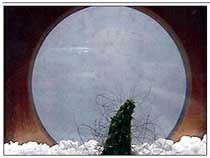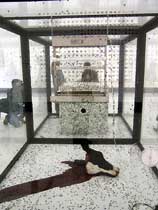
Artblog contributor Colette Copeland emailed to tell us about an article by Randy Kennedy in today’s NY Times. The story’s about art on the edge of science. Here’s the link.
In the story, “The Artists in the Hazmat Suits,” Kennedy mentions the case of Steven Kurtz, the Critical Art Ensemble member being pursued by the federal government for possible illegalities regarding some non-hazardous biological matter he procured for his art. Kurtz, whom we’ve told you about here, may get his day in court by the end of the year.
But the story doesn’t dwell at length on Kurtz. Instead it gives a larger context and questions the ethical nature of some of the work, which alters, for example, a cactus to have it sprout what looks like human hair.
(top image is “The Cactus Project” by Laura Cinti)
Kennedy also mentions Damien Hirst‘s highly marketable piece, “One Thousand Years,” a work that includes a vitrine with a rotting cow head, maggots and a bug zapper. Apparently the piece was purchased by Charles Saatchi. He also highlights art by bioart activists like Steven Zaretsky, whose work sounds like Fringe Festival material — wild.

Quoting from the article:
As biotechnology advances and bioart grows – several American universities are establishing centers for the art – it will undoubtedly become more difficult to tell where one leaves off and the other begins. And as artists are given ever more advanced tools for making their work, questions about how far the art can be pushed will only become harder to answer. Already, there are artists like Adam Zaretsky, an eccentric even in the eccentric world of bioart, who profess not to understand why everyone gets so worked up by its practical and ethical implications.
Mr. Zaretsky, who has worked at M.I.T. and San Francisco State University and describes himself as “between academic gigs,” has had numerous run-ins with university ethics and animal-use committees, which he describes as “rent-a-priests.” In one case, he was not allowed to stage a project at San Francisco State called the “Workhorse Zoo,” in which he sealed himself in glass room for a week with albino frogs, mice, flies, microscopic worms and an actively growing yeast culture – in other words, a group of typical scientific test subjects – and ended up eating some of the frogs, fish and mice as any predator desperate for a meal would. (The project ended up being staged at the Salina Art Center in Kansas in 2002.)
My feeling is that bioart is an important underground component of art’s larger whole and that it reflects and gives visual form to universal fears about the unstable nature of our world today. This art won’t harm people, but shackling it, censoring it and forbidding it will harm discussion about the issues it raises. And that’s bad for everyone.









